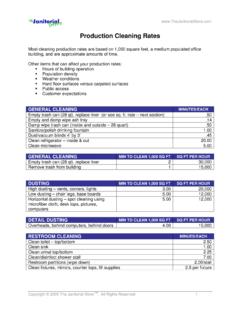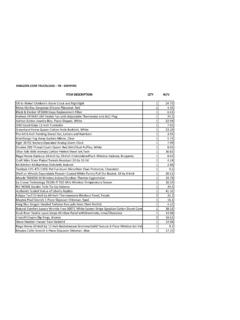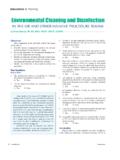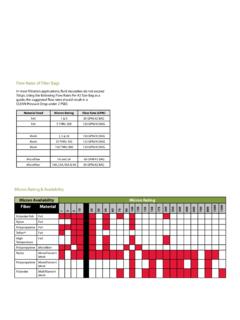Transcription of chapter 1 Cleaning Procedures and Products - …
1 3 IntroductIonPublic housing authorities (PHAs) should provide a safe and healthy environment for residents and visitors, and Cleaning of common spaces plays a vital role. Cleaning should be an environmental enhancement, not a source of unintended pollution. By def-inition, Cleaning is the removal of unwanted matter, contaminants, or pollutants from the environment, or the prevention of soiling; thus, it is or should be green. Cleaning is about removing pollution, not adding to it. The chapter covers two aspects of Cleaning : Cleaning Procedures , redefin-ing the processes or the ways in which Cleaning is performed, to enable the ef-fective removal of contaminants with-out adding unwanted substances to the environment or otherwise causing harm; Cleaning Products , using tools or agents that do not add or spread pollutants or cause other unintended effects.
2 Cleaning At-A-glAnCeIntroductionCleaning ProceduresImproving and Standardizing the Way to Clean Chemical ManagementEntryways and Lobbies Dusting, Dust Mopping, and Dry Floor Cleaning Floor Care: Hard Floors and Carpets Restrooms Disinfection OSHA Bloodborne Pathogen Standard Spills Food AreasReducing Solid Waste from Cleaning OperationsPest ManagementIndoor Plants People with Special NeedsCleaning ProductsAppendicesHousing Complex-Specific Green PlanEnvironmentally Preferable Cleaning Products and SuppliersPowered Equipment Use and Maintenance PlanAcronyms and Definitions in This ChapterToxicity Categories for Pesticide and Disinfectant Products chapter 1 | Cleaning Procedures and Products4 GREEN BUILDING OPERATIONS AND MAINTENANCE MANUALThe chapter concludes with appendices on.
3 Housing complex-specific green Cleaning plans Environmentally preferable Cleaning Products and supplies Powered equipment use and maintenance plan Acronyms and definitions Toxicity categories for pesticide and disinfectant the section on Cleaning Procedures , applicable Cleaning prod-ucts are mentioned, with their environmentally preferable selection criteria elab-orated upon in the Cleaning Products section and in the term green Cleaning highlights the need to clean up the Cleaning processes and Products themselves, because many commonly used interven-tions contain, add, or leave environmental pollutants or may cause harm in other ways. Green Cleaning benefits the environment and helps protect people, es-pecially vulnerable populations such as the elderly, the infirm, children, and the chemically-sensitive (see Appendix D for a definition).
4 Their long- or short-term exposure to toxic chemicals or harmful particles, gases, or vapors can have seri-ous consequences such as asthma, allergies, depression, hormonal changes, or even Procedures Before starting to clean, read product and equipment labels and usage instruc-tions. Wear recommended Personal Protective Equipment (PPE), which may include rubber or surgical-type gloves, goggles, dust mask or respirator, earplugs, or other equipment. Improving and standardizing the Way to cleanImproving Cleaning Procedures involves changing the way or the focus with which Cleaning is performed to better prevent or remove soils, contaminants, or pollutants, and to select and use less toxic Products . These processes should be integrated into a system of Standard Operating Procedures (SOPs) that are part of the overall operations and maintenance plan for the managers ideally should develop and maintain SOPs as a set of written guidelines that govern: Cleaning Procedures AND Products 5 Cleaning Procedures Chemical handling and tracking requirements Equipment maintenance and operation Procedures Communication protocols and requirements Training and inspection programs, and Reporting and record-keeping Procedures .
5 These guidelines should be made available to all Cleaning personnel and occupants. In addition, if desired, a more in-depth housing complex-specific Green Cleaning Plan (see Appendix A) may be developed for every building or building-set to be cleaned. chemical Management: reducing Waste, efficient use Minimizing the effects of toxic Cleaning chemicals requires building managers to work and communicate with Cleaning staff, the PHA management or owners, and occupants. Suggested Activities in a Green Cleaning ProgramGive clear guidance to Cleaning staff on handling Cleaning chemicals: Provide easily understood directions to Cleaning staff in appropriate written languages or graphic representation for the dilution of chemical Cleaning Products . Track the quantities of Cleaning chemicals used over time on at least a quarterly basis.
6 Use a chemical measuring and dilution control system that limits worker exposure to chemical concentrates while facilitating the proper dilution of these concentrates ( , wall-mounted dispensing systems where con-centrates are sequestered and dispensed remotely and Cleaning chemical is automatically mixed with water for proper end-use dilution without the worker needing to touch concentrates). Use the appropriate technology (coarse spray or squirt bottles, automatic chemical dispensers on powered equipment, etc.) for applying the chemical product to avoid aerosolization, overuse, or waste. Provide directions for the proper rinsing and disposal of expended or empty chemical solution GREEN BUILDING OPERATIONS AND MAINTENANCE MANUAL Prevent other building areas from being adversely affected.
7 Reduce, minimize, or eliminate the need for using Cleaning chemicals if possible. Train new and current employees: Provide employees with initial, on-site, site-specific, and annual in-service training. Training should be done in a manner that respects unique needs of the employee, such as limited English proficiency, physical challenges, or learning disabilities. All employees should receive training and/or education on an annual basis to maintain knowledge of correct Procedures for safety, tools, techniques, and pertinent environmental standards. Train Cleaning personnel in the proper handling of chemicals, proper use and maintenance of equipment, and proper Cleaning Procedures . Train purchasing personnel in the selection of green Cleaning materials. Train management/supervisors through in-service training and/or educa-tion on an annual basis on policies and Procedures .
8 Train new Cleaning personnel on standard operating Procedures , the prop-er sequencing of Cleaning steps, and the proper use of personal protec-tive equipment. This training may occur before personnel are assigned to a facility or at the site before beginning independent work. Follow up with in-service training, continuing education, and/or professional development opportunities on an annual basis. Give all personnel standard safety training, including how to reduce and prevent ergonomic injuries and exposure to hazardous materials. Provide site-specific training focusing on standards for the facility to which workers will be assigned. This site-specific training should cover: facility-specific Cleaning instructions, tailored procedural training ( , servicing areas for vulnerable populations) based on the needs of the facility and oc-cupants, and hazardous communication standards.
9 Maintain records of training on each employee. The documentation should include a general outline of information covered, the name and qualifica-tions of the trainer, and the date(s) and duration of the training or courses. It is recommended that records be retained for two years from the hiring date of current employees, and one year for former employees. PHAs that con-tract green Cleaning services may want to consider requiring GS-42 Cer-tification (see Appendix D Definitions) or evidence of GS-42 compliance from their service provider. Criteria from LEED-EBOM and CIMS-GB are also helpful guides (see Appendix D Definitions). Cleaning Procedures AND Products 7 Encourage communication with building management/owners, employees, and occupants: Develop a system for Cleaning service employees to provide comments and suggestions about workplace issues and suggestions for improvements in the provision of services.
10 Communicate to the public housing management or owners of the build-ing the presence of pests and any maintenance issues discovered during Cleaning operations. Provide materials to occupants that define opportunities to reduce the need for more intensive Cleaning processes or treatments ( , reporting spills and making attempts to reduce clutter in common areas). Notify occupants about all Cleaning Products used in the facility. This should include a list of all chemicals that may be used. It also should include the name, address, and phone number of the PHA contact person; a statement that the contact person maintains the product labels and Material Safety Data Sheets (MSDSs) of each product used in the building; and that the labels or MSDSs are available for review upon request.








